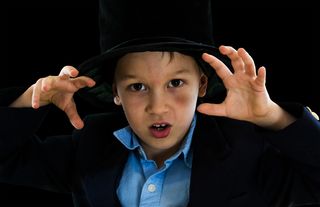Fantasies
Do You Believe in Magic?
How children learn to distinguish between fantasy and reality.
Posted November 4, 2019 Reviewed by Lybi Ma
Just like every other parent of a preschooler, the movie Moana is very popular in my house. So popular that I would say I’ve seen it over 100 times, and my sons still ask to watch it nearly every day. You’d think after watching the same movie over and over again, my children would know it backward and forward, without any questions about the storyline or characters. Think again.
One of the first questions I got from my 4-year-old when we first saw the movie was where real lava monsters lived, like the movie character Te Kā, and whether any of them lived near our house. I explained then that lava monsters aren’t real, it was just a movie, just pretend. A year and what feels like about 1000 viewings later, and he still occasionally asks me to show him photos of real lava monsters on my phone, and asks whether they only live in places where there are active volcanoes.
Discriminating fact from fiction isn’t an easy task for children. In fact, it isn’t an easy task for adults either. Indeed, a recent study by researchers at Stanford University suggests that middle schoolers, high schoolers, and even college-aged students are notoriously bad at identifying false information (Wineburg, McGrew, Breakstone, & Orgega, 2016). How then do children learn the difference between what’s real and what’s not?
Part of the difficulty of making this distinction is that children receive both real and fictional information through media—in books and on screens. For example, books are often used to portray factual information that can seem like fantasy—such as information about space exploration—in the same format that they receive fantasy information that can seem real—such as in movies or books where fictional characters look and act like everyday people. Besides the fact that different kinds of information are presented through the same medium, there is evidence that children have issues with the medium itself. Interpreting what children see in books and on screens involves reasoning about symbols or something that represents something other than itself. Children are only starting to reason about symbols by ages 3 and 4, and most children are exposed to symbolic media well before that age.
For example, despite having seen photos before, babies don’t understand what to do with them or what photos represent. Several studies have shown that 9-month-olds reach and grasp for images depicted in books and on television as if they were the real objects (DeLoache, Pierroutsakos, Uttal, Rosengren, & Gottlieb, 1998; Pierroutsakos & Troseth, 2003). In other words, they try to pick up objects that they see in photos and videos right off the page or screen. In several studies, researchers also find that children have trouble using information about a hidden toy in a scale model to find a larger version of the same toy in a real room (DeLoache, 1987).
Similarly, another group of researchers presented 3- and 4-year-olds with a television screen depicting a bunch of balloons and asked them whether they thought the balloons would fly out of the top of the TV if the researcher took the lid off. It wasn’t until age 4 that children reliably said no—3-year-olds thought that the balloons would, in fact, fly right out of the top of the TV (Flavell, Flavell, Green, & Korfmacher, 1990).
So how do they figure it all out? In media, there is evidence that children use context to guide their beliefs about what is real and what is pretend. For example, in a study that looked at whether 3- to 7-year-olds can differentiate between historical figures like Abraham Lincoln and fictional characters like Harry Potter, children of all ages were able to judge who was real and who was not. However, only the older children (age 5 and up) were able to make judgments about whether a brand new character was real or not by paying attention to the elements of the book and whether they were realistic or whether they had elements of fantasy embedded in the story (Corriveau, Kim, Schwalen, & Harris, 2009).
Similarly, other studies have shown that children as young as 3 can use contextual information from stories to decide whether its content can be applied to the real world: If the story has realistic elements in it, children are more likely to think that the events in the story can happen in real life than if the events in the story have fantasy elements or, for example, if the story has animal characters that talk and wear clothes (e.g., Ganea, Canfield, Simons-Ghafari, & Chou, 2014; Walker, Gopnik, & Ganea, 2015). The same goes for television: 4-year-olds can judge the events in a cartoon as just pretend; however, if the same events are presented with a more realistic background, nearly half the children judged them to be real (Li, Boguszewski, & Lillard, 2015).

Besides context, children also rely on what other people tell them—what researchers call testimony. Parents’ testimony is usually a pretty reliable way to learn about the way the world works, and children typically trust what adults tell them (e.g., Jaswal & Neely, 2006). In this way, learning from a reliable adult, like a parent or teacher, about what’s real and what’s not is a way children can figure it all out. However, there are some cases where adult testimony encourages children’s fantastical beliefs (Rosengren, Kalish, Hickling, & Gelman, 1994). In fact, children aren’t the only ones who believe in the fantastical—adults often have supernatural beliefs of their own, like the belief in ghosts or religious miracles, and in other cases, parents encourage children to believe in magical characters, like in the belief of Santa Claus or the Easter Bunny.
Indeed, while 5- to 6-year-olds who are brought up in non-religious families judge characters in religious stories who performed fantastical acts to be fictional, children of the same age growing up in religious families judge those same characters to be real (Corriveau, Chen, & Harris, 2015). Further, 4- and 5-year-olds easily make correct judgments about what kinds of events are possible and impossible—like that a cup can’t turn into a cat—except if they’re told the impossible event was performed by a magician (Rosengren, Kalish, Hickling, & Gelman, 1994).
Besides testimony, children also rely on evidence that they observe themselves to support whether something is fact or fiction. In fact, as young as age 4, children will even override the inaccurate testimony of an adult when the child observes conflicting information himself. For some fantastical beings, like Santa Claus or the Easter Bunny, all testimony (e.g., what parents say) and evidence (e.g., toys under the tree, hidden eggs around the house) points to their existence. At some point, children will begin to obtain both testimony and evidence to the contrary from their friends at school or from learning about the physics of what’s possible and impossible.
They’ll question old evidence, seek out new evidence, and most children will eventually decide for themselves what’s real and what’s not. Thus in time, most children discard their childhood fantasies on their own, but as the holiday season approaches, some parents might hope that they’ll perhaps hang on to a precious few, at least for now.
References
Bridgers, S., Buchsbaum, D., Seiver, E., Griffiths, T. L., & Gopnik, A. (2016). Children’s causal inferences from conflicting testimony and observations. Developmental Psychology, 52(1), 9.
Corriveau, K. H., Chen, E. E., & Harris, P. L. (2015). Judgments about fact and fiction by children from religious and nonreligious backgrounds. Cognitive Science, 39(2), 353-382.
Corriveau, K. H., Kim, A. L., Schwalen, C. E., & Harris, P. L. (2009). Abraham Lincoln and Harry Potter: Children’s differentiation between historical and fantasy characters. Cognition, 113(2), 213-225.
DeLoache, J. S. (1987). Rapid change in the symbolic functioning of very young children. Science, 238, 1556-1557.
DeLoache, J. S., Pierroutsakos, S. L., Uttal, D. H., Rosengren, K. S., & Gottlieb, A. (1998). Grasping the nature of pictures. Psychological Science, 9, 205-210.
Flavell, J. H., Flavell, E. R., Green, F. L., & Korfmacher, J. E. (1990). Do young children think of television images as pictures or real objects? Journal of Broadcasting & Electronic Media, 34, 399-419.
Ganea, P. A., Canfield, C. F., Simons-Ghafari, K., & Chou, T. (2014). Do cavies talk? The effect of anthropomorphic picture books on children's knowledge about animals. Frontiers in psychology, 5, 283.
Jaswal, V. K., & Neely, L. A. (2006). Adults Don't Always Know Best: Preschoolers Use Past Reliability Over Age When Learning New Words. Psychological Science, 17(9), 757-758.
Li, H., Boguszewski, K., & Lillard, A. S. (2015). Can that really happen? Children’s knowledge about the reality status of fantastical events in television. Journal of Experimental Child Psychology, 139, 99-114.
Pierroutsakos, S. L., & Troseth, G. L. (2003). Video verite: Infants’ manual investigation of objects on video. Infant Behavior and Development, 26, 183-199.
Rosengren, K. S., Kalish, C. W., Hickling, A. K., & Gelman, S. A. (1994). Exploring the relation between preschool children's magical beliefs and causal thinking. British Journal of Developmental Psychology, 12(1), 69-82.
Walker, C. M., Gopnik, A., & Ganea, P. A. (2015). Learning to learn from stories: Children's developing sensitivity to the causal structure of fictional worlds. Child development, 86(1), 310-318.
Wineburg, S., McGrew, S., Breakstone, J., & Ortega, T. (2016). Evaluating information: The cornerstone of civic online reasoning. Stanford Digital Repository. Retrieved January, 8, 2018.




